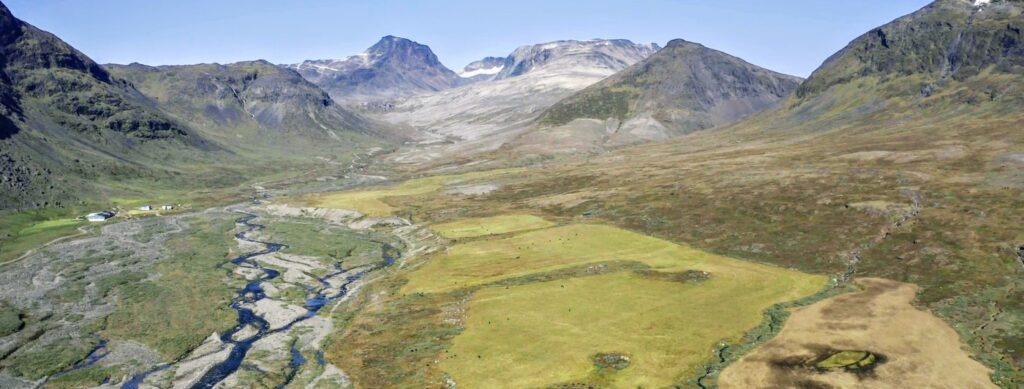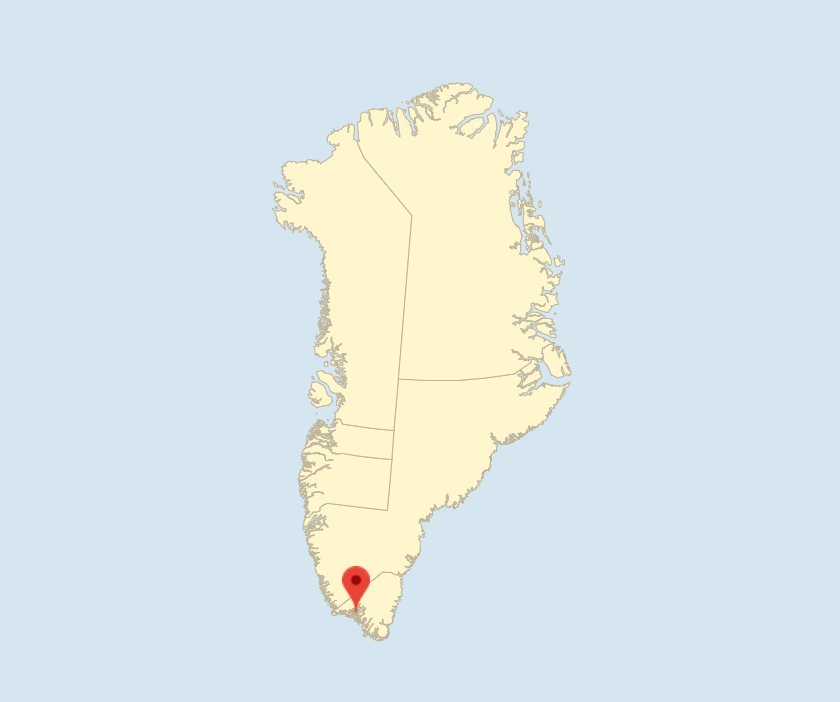
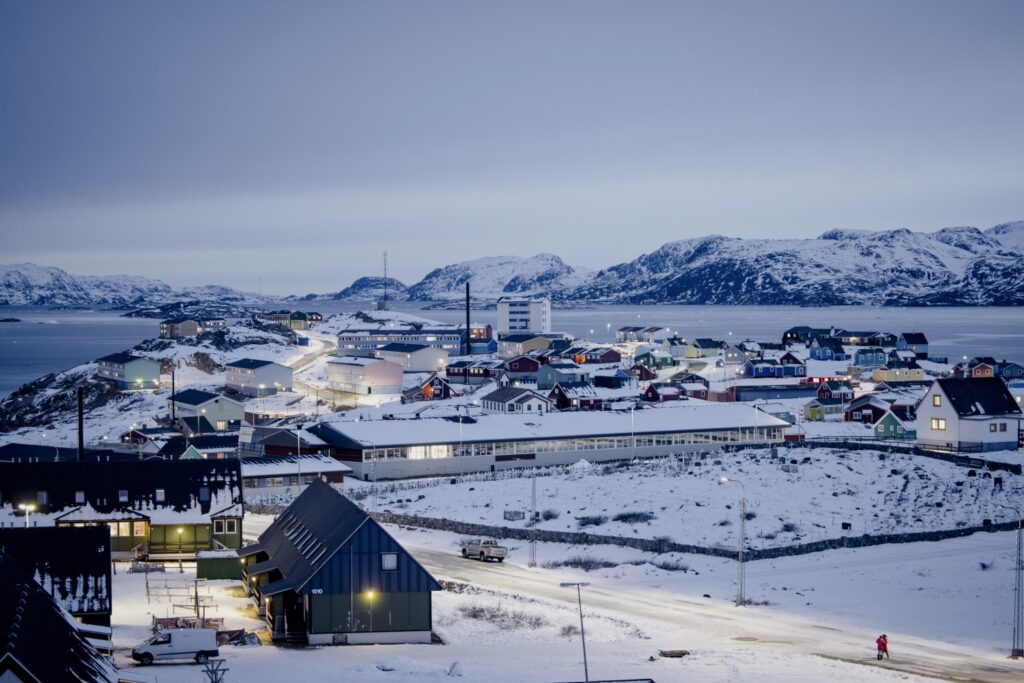
VALDEMAR REN/RITZAU SCANPIX, 2021
Narsaq, meaning ‘the plain’, is situated on a large, flat grassy peninsula surrounded by the fjords Tunulliarfik (Eriksfjord) and Ikersuaq (Bredefjord). The town has 1,392 inhabitants. The strait west of the town often has vast amounts of icebergs and to the northwest, the 685 m high mountain Qaqqarsuaq.
History of Narsaq
The area has been inhabited by early Inuit immigrations, but when the Norse settled from the year 985, it had been depopulated over several hundred years. Up to the 1400s, the Norse developed an agricultural culture with a relatively large population in the fjord systems. Towards the end of the Norse period, Inuit began to come far south, and a cultural encounter ensued. After the Norse left Greenland around the second half of the 1400s, Inuit lived in the resource-rich area with good hunting opportunities that allowed relative population density. In the following centuries, a new cultural encounter emerged, first sporadically with European whalers and later more systematic with colonisation.
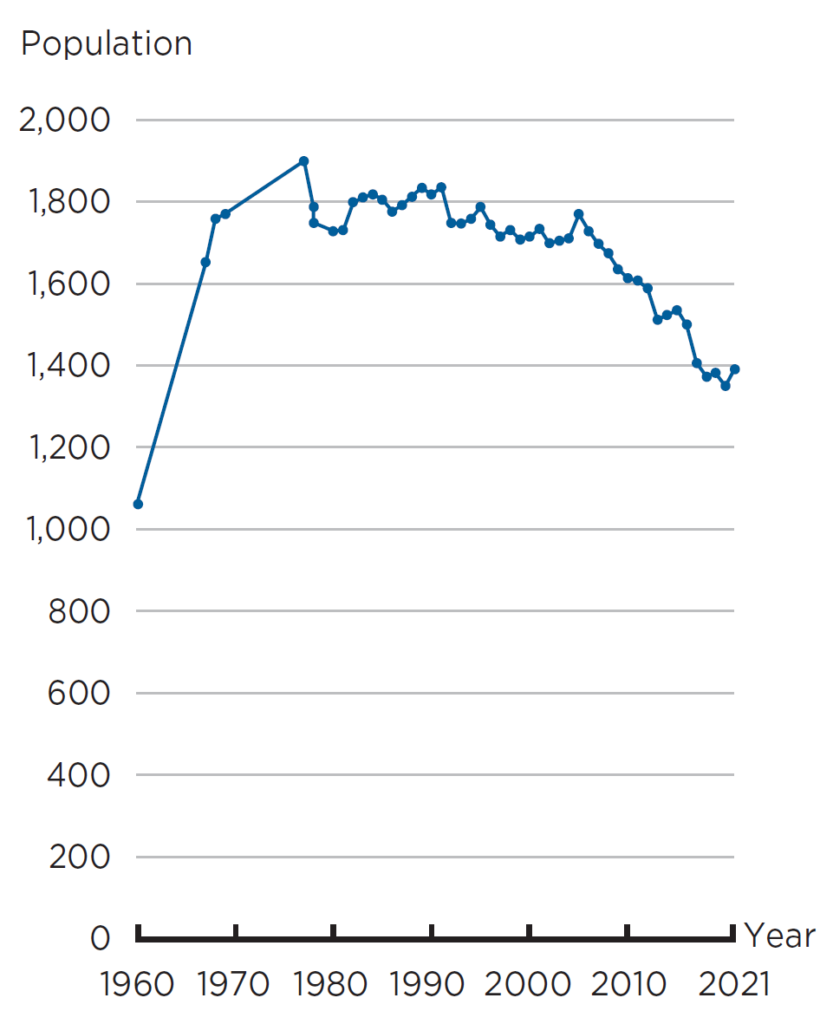
GRØNLANDS STATISTIK
Up through the 19th century, livestock farming gradually became a complementary livelihood, primarily among the descendants of Igaliku’s founders, the Norwegian merchant Anders Olsen and his Greenlandic wife, Tuperna.
In 1830, the Royal Greenland Trading Department (KGH) established the remote trading post Nordprøven under the colony of Julianehåb (today: Qaqortoq). The name was quickly replaced by the Greenlandic Narsaq, also in the colonial administration. Around 1880, a place of call and a trading post with a shop were established in the bay at the outlet of the Kuukkasik river. In 1919, Narsaq was Greenland’s largest remote trading post with 162 inhabitants.
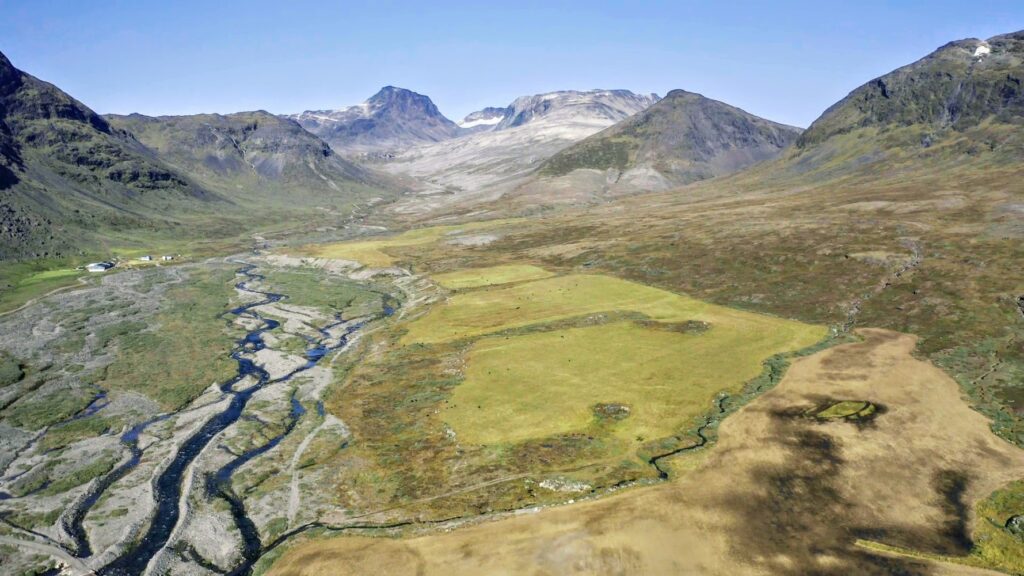
GREENLAND MINERALS LTD/HANDOUT VIA REUTERS/RITZAU SCANPIX, 2020
From the late 1920s, full-time sheep farming became more prevalent in Narsaq and in southern Greenland. By 1930, the population had grown to 299.
During World War II, the United States established the Bluie West One airport at Narsarsuaq at the head of the Tunulliarfik fjord as well as a weather and telegraph station, Bluie West Three, at Simiutaq. Narsaq is located right in the middle, and an interaction with the American soldiers occurred.
After World War II, during modernisation, Narsaq was prioritised because there were good seafaring conditions, while Qaqortoq was more often isolated by the storis (great ice). Moreover, the fjords at Narsaq had favourable conditions for cod and shrimp fishing, just as the town was the centre of sheep farming.
By 1947, the population had grown to 434. In 1950, Narsaq Municipality was created and Narsaq was granted the status of town in 1959.
KGH established a shrimp cannery and a sheep slaughterhouse in 1951, and 40 homes were built for employees. On the same occasion, the slaughterhouse in Qaqortoq was closed. In the late 1940s, fox farms were established and from 1964 to 1969 mink farms – using fish waste from the factory as feed.
To ensure supplies, a wharf was built for small freighters in 1952, and in 1959 the fish factory was extended to include freezing of shrimp and cod fillets. All of South Greenland’s fish processing activities were brought together in Narsaq, and fish and shrimp traded in the Nanortalik and Qaqortoq districts were sailed to the town. From 1961, there was a decline in shrimp trading, and towards the end of the 1980s the cod disappeared from southern Greenland waters.
During the 1960s and the following decades, there was massive construction activity with 16 private contractors and 95 employees (in 1969), and the town had the heliport in 1966.
Narsaq grew to 1,835 inhabitants in 1991, but since then the population has declined, particularly as a result of the closure of the shrimp factory, boosted by the municipal amalgamation in 2009, when administrative jobs moved to Qaqortoq.
Uranium in Kuannersuit
In 1956, uranium was discovered in Kuannersuit (Kvanefjeld) about 8 km north of Narsaq, and several test drillings were carried out. Kuannersuit was part of the Danish plans to develop nuclear power, boosted by the 1973 oil crisis, as well as of the construction of the Risø experimental plant at Roskilde Fjord. The discovery of uranium was instrumental in the Danish authorities developing Narsaq, and the expectation was that the employees of a future uranium mine would live in the town. During the period, the majority of townspeople had high expectations for the project.
International opposition to nuclear weapons and nuclear power gradually put an end to the intentions of Danish nuclear power, and popular opposition was reinforced by the reactor meltdown on the Three Mile Island in the United States in 1979. In 1984, the Folketing (the Danish Parliament) agreed that nuclear power should not be part of the Danish energy supply, and the exploration at Kuannersuit was discontinued. Inatsisartut (Parliament) adopted a zero tolerance for uranium mining in 1988, which implied that ore must contain no more uranium than natural background radiation.
In 2007, Australian company Greenland Minerals and Energy was granted a licence to search for rare earths in Kuannersuit – with uranium as a by-product. It sparked a long-running debate about environment versus jobs and revenue to fund Greenlandic independence. First, zero tolerance was lifted in 2013, and after the 2021 elections, with a clear majority in Inatsisartut opposed to the Kuannersuite project, a new and slightly less restrictive zero tolerance was adopted. The new law makes mining at Kuannersuit unlikely, and a legal aftermath remains between the mining company and the Self-Government.
The years of discussions for and against uranium and jobs versus the protection of nature and the environment and the development of agriculture, tourism and fishing have been gruelling for the people of Narsaq.
Infrastructure of Narsaq
The Greenland Technical Organisation’s (GTO) focus on Narsaq has meant good infrastructure; most of the roads are paved, the water supply network is good and the town has virtually a full sewer system. The electricity comes from the Qorlortorsuaq hydropower plant, which also supplies Qaqortoq, but the plant does not yet have capacity for electricitybased heating of homes in Narsaq.
The Royal Arctic Line arrives at the town once a week with supplies. Disko Line has daily passenger services with smaller ships to Narsarsuaq and Qaqortoq and a few times weekly to the nearby settlements – however, capacity is a challenge. Air Greenland has a helicopter connection to Narsarsuaq and Qaqortoq a few times a week.
Trade and industry in Narsaq
Today, Narsaq is the centre of food processing in southern Greenland. The slaughterhouse Neqi A/S has approximately 80 employees during the three months of the slaughtering season and about 25 for the rest of the year. In addition to sheep farming, Narsaq is home to Greenland’s largest cattle farm, beginning in 2004 with three cattle of the Irish Dexter breed in Narsap Ilua. Out of about 250 cattle, the farmer sent 58 animals to the slaughterhouse in 2020.
Local business initiatives include the Greenland Brewhouse, established in 2008 and now taken over by Qajaq Beer, the Inuili Food College Greenland with about 25 employees, and the Royal Greenland’s factory, which mainly trades in cod and roe, has up to 10 employees. In addition, the primary employment in Narsaq is in public administration and service.
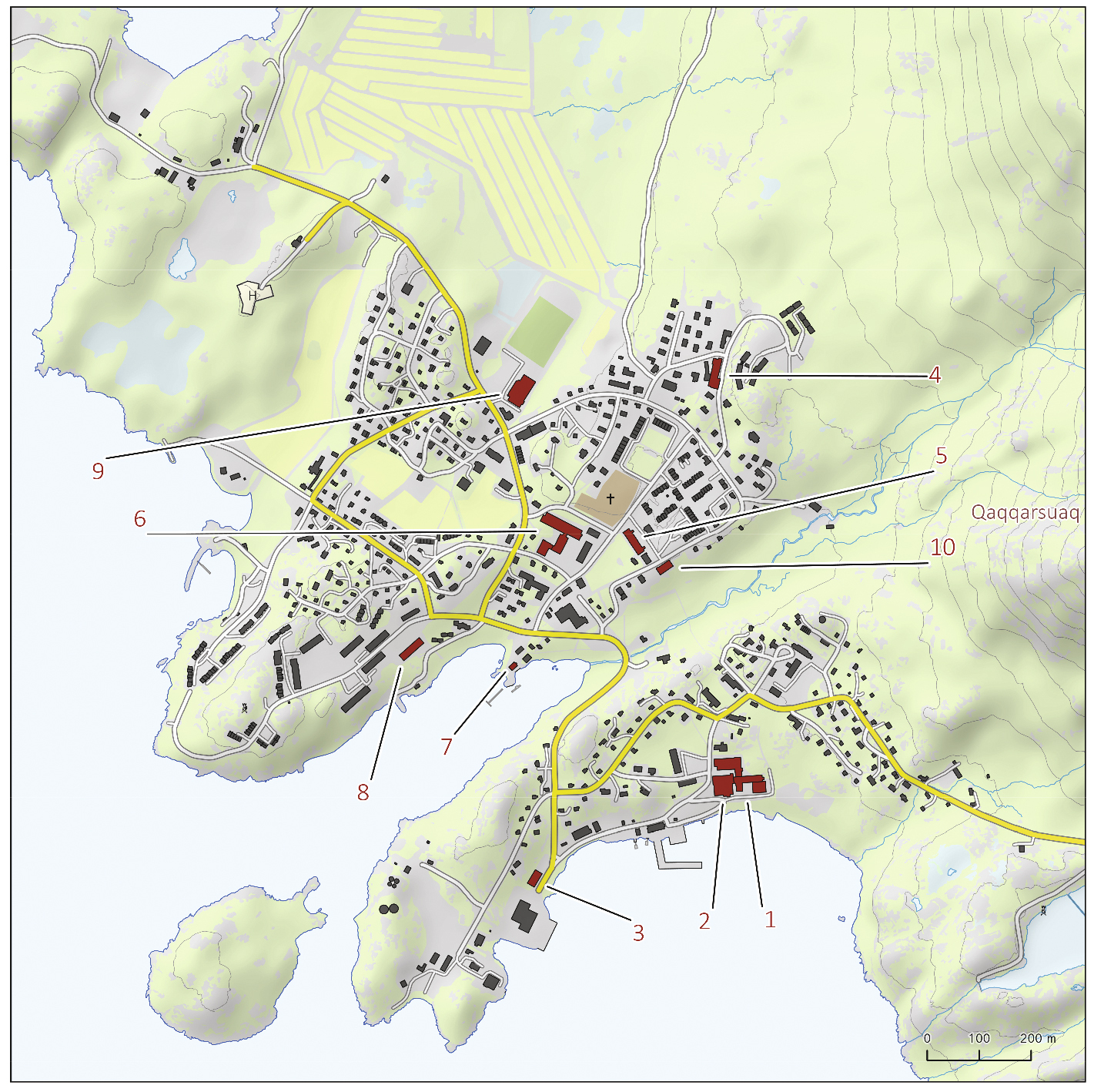
ASIAQ, 2022
Further reading
- Agriculture in Greenland
- Industry and labour market
- Infrastructure
- Kommune Kujalleq
- Locations with agriculture and sheep farming
- Nanortalik
- Narsarsuaq
- Population and demographics
- Qaqortoq
- Towns and settlements
Read more about the Municipalities and towns in Greenland

